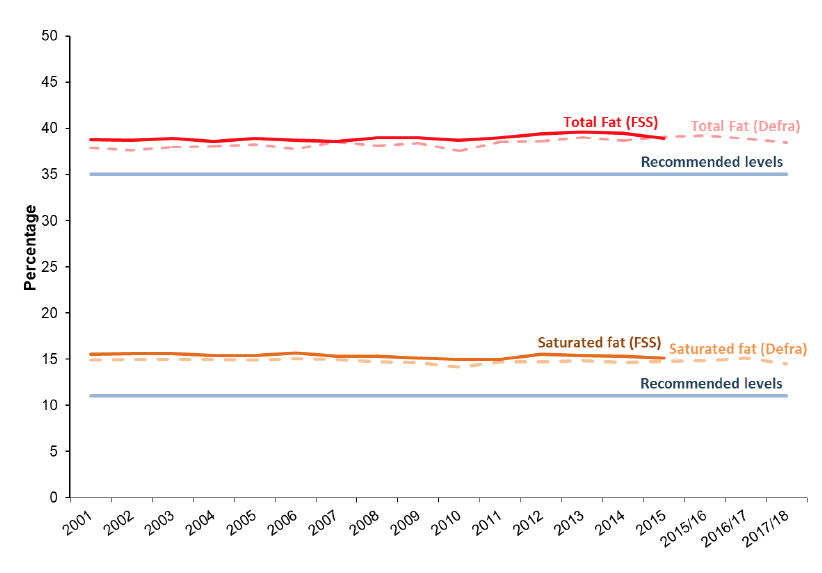Diet and healthy weight: monitoring report 2020
Latest results against the obesity indicator framework originally developed to monitor progress against our Prevention of Obesity Route Map (February 2010), now superseded by the Diet and Healthy Weight Delivery Plan and Active Scotland Delivery Plan (summer 2018).
This document is part of a collection
Total and saturated fat
Footnote[12]
Food Standards Scotland (FSS) analysis of published data from Department for Environment, Food and Rural Affairs (Defra)[13]
Latest results[14]
- In 2017/18, the percentage of total food energy from all fats was 38.5%, above the Scottish Dietary Goal of no more than 35%.
- The percentage of total food energy from saturated fat was 14.5%, compared with the Scottish Dietary Goal of no more than 11%.

Source
The UK Family Food survey is an annual publication which provides information on purchased quantities, expenditure and nutrient intake derived from both household and eating out food and drink. FSS secondary analysis data for Scotland on total fat and saturated fat are not available after 2015 due to the small sample size for Scotland. Since 2015 data on progress on the percentage energy from total fat and saturated fat have been calculated from the figures published in the Defra Family Food Dataset (by combining both household and eating out data for Scotland). The small difference between the FSS and Defra values is likely to be due to consideration of the amount of food and drink wastage in the FSS calculation.
Equalities
Information on differences in food and nutrient intake by deprivation (using the Scottish Index of Multiple Deprivation (SIMD)) is not available for Scotland after 2015. This is due to a reduction in sample size which limits sub-group analyses.
Geography available
Scotland level.
Rationale for including total and saturated fat
These data are useful to monitor change in the proportion of the population consuming energy dense foods and progress towards the Scottish Dietary Goals. Currently people are eating more saturated fat on average than is recommended (FSS Barton et al, 2018[15]). Prevalence of obesity indicates that energy intakes currently exceed energy requirements. Both these issues raise serious health concerns, particularly in relation to coronary heart disease, high blood pressure, stroke, Type 2 diabetes and certain types of cancers[16].
Recommendations for food and nutrient intake are based on advice from the Committee on Medical Aspects of Food and Nutrition Policy (COMA) and the Scientific Advisory Committee on Nutrition (SACN). Published Dietary Reference Values cover a range of intakes for most nutrients and for fat and saturated fat are set as a percentage of daily energy intake for adults.
Factors influencing total and saturated fat
Availability, cost, and access to different food types.
Contact
There is a problem
Thanks for your feedback